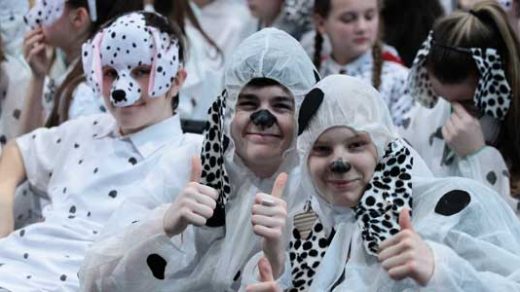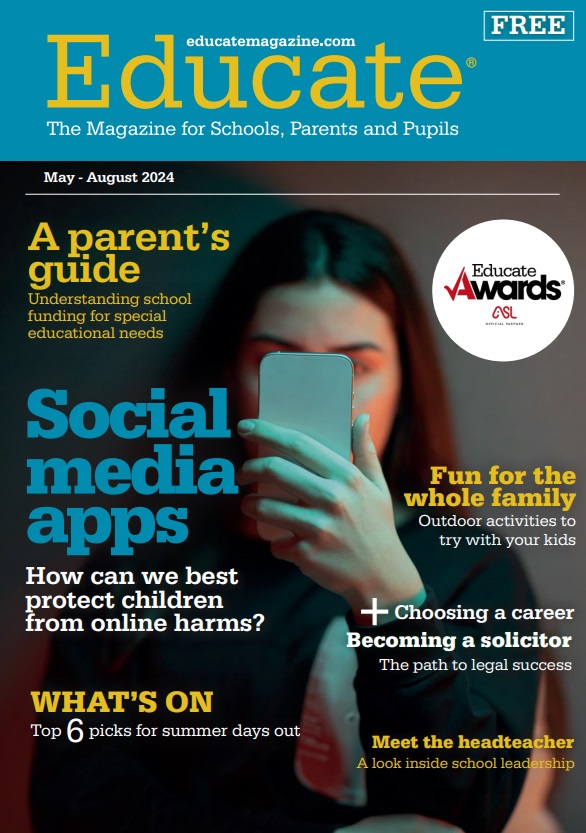Interview with: Dr John Patterson, headteacher of St Vincent’s School

Bringing increased opportunities to young people with VI
In this issue, Educate magazine speaks to Dr John Patterson, headteacher of St Vincent’s School in West Derby to find out more about his career and what inspired him to become a teacher, as well as how the specialist school for sensory impairment is leading the way in innovative education.
As we connect via Zoom, Educate is greeted by not only John sat at his desk in his office, but also a beautiful liver and white springer spaniel in his arms.
“This is Penny!” John exclaims. Penny takes on a special role at St Vincent’s as the school’s therapy dog but you can tell that she also has a special place in John’s heart. As Penny settles down with her chew toy, the interview begins.
Before joining the teaching profession, John was an engineer. It was his mother who inspired him to retrain and become a teacher. John said: “The joy of starting in engineering is that I know how to make stuff. I’m good at the ideas which is beneficial to my role now.
“The reason I retrained was actually down to my mother. During one summer, as I’m covered in oil and all sorts of stuff, she said, “Come with me!” and we went down to Christ’s and Notre Dame College, now Liverpool Hope University. It was a beautiful summer’s day, there were students sat outside enjoying themselves. She asked, “Wouldn’t you rather be here, son?” So, I said, “Well, yes!” and she said, “Right, leave, go and get your exams, and I’ll look after you.” So, I did and she did.”
After university, John went in to primary education in inner-city schools. “The things I was doing meant that I was actually headhunted to write educational ideas for an educational programme. I was very fortunate as I got to pilot loads of creative ideas that connected technology with sports which was great as I was able to learn so much.
“It was that, that got me into Liverpool Hope University and I became a lecturer and head of PE across teacher training and teacher education programmes. This gave me years of experience in research and how that impacts policies and that’s how I did my masters and my PhD – researching innovation in education.”
John was at Hope University for 12 years. During his time there, he would get seconded out to do entrepreneurial learning at other universities and schools. He continued: “That was what I was good at – the enterprise, the innovation and the new ideas.”
“I was then asked to set up a free school by the government in the city so I wrote the curriculum and was asked to be the headteacher until the Department for Education was interested in finding another school to do the curriculum that I had written. I knew St Vincent’s and I had done projects with the school before and they told me they were looking for a headteacher and it was at that point in time, my strength and skills were what was needed at the school, so I applied and I got the job!”
It was at this moment John realised the path he was embarking on was fate. He said: “It was strange, all the years of experience and all my knowledge, strengths and skills all came into what was needed here and that is where I wanted my energy to go. I felt like it was meant to be – this is what all the learning was for.”
John has been at St Vincent’s for over seven years and has brought an array of opportunities and tailored learning to his students.
He said: “The overall aim is to bring increased opportunities to our young people and to challenge the high unemployment rates that are around 85% – this sadly hasn’t changed much over the years.
“On average, individuals with visual impairment (VI) have five to six less friends, so the challenge for this school is the individual learning outcomes. VI is different for every single child, it is really complex the teaching that needs to be designed.”
A lot can happen in seven years and John recalls the many milestones he has witnessed. John said: “Being given the Freedom of the City of Liverpool was a key milestone. A corporate award from Liverpool John Moores University was key. An Educate Award for Innovation in Education was definitely a ‘Hallelujah’ moment, because that is where companies start to recognise you and ask for more information on what you are doing, which leads to more opportunities for our children.”
But it’s not just about the school’s milestones, John gets pleasure from individual success stories.
He said: “One of our children won an international peace essay and he called it ‘Journey for Peace’. It was based on key statues in Liverpool and their journey for peace. These statues tell stories for example, the Ken Dodd statue, and we then made those stories into seven comics and each one has a citizenship theme.”
The Journey for Peace idea is open for all schools to utilise now on the St Vincent’s website www.stvin.com. The project aims to bring people together via their school communities of learning through five simple steps which are adaptable to each school community. The common goal is to support and invest in VI young people around the world.
Like all schools, it has been affected by the pandemic but the children at St Vincent’s are used to adjusting to new environments. He said: “Our children are used to adapting to things and are sadly, quite used to the feeling of isolation. The individual impact is obviously the friendship groups and being in small bubbles – that has been a real challenge for our children.
“Quite a lot of our children have come from backgrounds where they are the only visually impaired child in the school but now they have come here, they are just the same as everybody so we were aware that some felt like they were going back to how it was before they came here.”
Amongst the many initiatives St Vincent’s has created and developed, John seems most proud of Sightbox. It was created by his students who were extremely concerned with the lack of access to equipment and technology for visually impaired children and individuals living in third-world countries.
The school began working with the Liverpool Rotary Club and worked to fund and create the Sightbox which was shipped to children who were visually impaired. It is a container filled with equipment which provides blind and visually impaired children with the technology needed to access sports and have a more independent lifestyle.
He said: “These boxes have been sent around the world, funded by the Rotary Club. Places such as Pakistan, India, Rwanda, Sierra Leone, Indonesia, Uganda, Malawi and Ethiopia to name a few.
“Now our children are using Zoom to teach those children how to use the Sightbox. Overseas the impact of those resources are phenomenal. A lot of children overseas don’t have any education whatsoever so it’s a local, national and global picture. I see it as a post-Brexit new trade innovation led by visually impaired young people. It is something that the government should be listening to.”
Another project the school has rolled out is Reclaim the Green, Reclaim the Nature. It is aimed at taking pupils of St Vincent’s and establishing them as leaders to encourage young people into not only becoming an agent of change but also innovators of innovators.
“Our young people have designed a number of ideas but we’re going to take into full production and make them. For example, carbon capture on the front of a car or green energy that can be made by the sea. We are almost doing all of those innovative ideas so that they can be sold and our children can be trainers and can earn a living.
“We need to invest in VI young people’s creativity and innovation. If we can showcase how well our education can work and that our children can be trainers of the trainers, this is where there is international new trade.”
At St Vincent’s, technology and innovation plays a big part in the curriculum. John said: “Technology has its place and it is burgeoning for us, it is key in a sense of where the opportunities for employment may lie in the future. Who knows, our current 10 and 11 year olds may work in industries not yet created. We want to be involved in that teaching and learning because we want our children to be the innovators.”
Employment opportunities for VI young people are unfortunately limited. John believes there needs to be more awareness raising. He said: “We need VI awareness to get off the ground more and there needs to be investment in VI creativity. These projects that I have talked about are helping to breakdown these perceptions and are generating awareness and increasing opportunities.”
What does John hope to achieve over the next seven years? He said: “We want to do VI games, and we have already started the process for that. The disability games were going to be in Liverpool but there was not enough for VI so we’re going to do our own VI games.
“We of course want more children getting employment through our creativity and also more Sightboxes reaching more countries with our children being the trainers of the trainers.”
He concluded: “Yes, we have got some big ideas at St Vincent’s but we believe they are achievable.”




